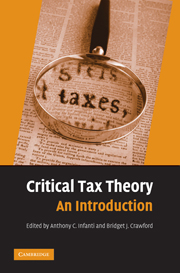Book contents
- Frontmatter
- Contents
- List of Illustrations
- List of Tables
- List of Contributors
- List of Common Abbreviations
- Introduction
- CHAPTER 1 FOUNDATIONS OF CRITICAL TAX THEORY
- CHAPTER 2 HISTORICAL PERSPECTIVES ON TAXATION
- Dollars and Selves: Women's Tax Criticism and Resistance in the 1870s
- Split Income and Separate Spheres: Tax Law and Gender Roles in the 1940s
- The Rhetoric of the Anti-Progressive Income Tax Movement: A Typical Male Reaction
- CHAPTER 3 THE GOALS OF TAX POLICY
- CHAPTER 4 CRITICAL TAX THEORY MEETS PRACTICE
- CHAPTER 5 RACE AND TAXATION
- CHAPTER 6 GENDER AND TAXATION
- CHAPTER 7 SEXUAL ORIENTATION AND TAXATION
- CHAPTER 8 THE FAMILY AND TAXATION
- CHAPTER 9 CLASS AND TAXATION
- CHAPTER 10 DISABILITY AND TAXATION
- CHAPTER 11 GLOBAL CRITICAL PERSPECTIVES ON TAXATION
- CHAPTER 12 CRITICAL PERSPECTIVES ON CRITICAL TAX THEORY
- Index
Split Income and Separate Spheres: Tax Law and Gender Roles in the 1940s
Published online by Cambridge University Press: 04 August 2010
- Frontmatter
- Contents
- List of Illustrations
- List of Tables
- List of Contributors
- List of Common Abbreviations
- Introduction
- CHAPTER 1 FOUNDATIONS OF CRITICAL TAX THEORY
- CHAPTER 2 HISTORICAL PERSPECTIVES ON TAXATION
- Dollars and Selves: Women's Tax Criticism and Resistance in the 1870s
- Split Income and Separate Spheres: Tax Law and Gender Roles in the 1940s
- The Rhetoric of the Anti-Progressive Income Tax Movement: A Typical Male Reaction
- CHAPTER 3 THE GOALS OF TAX POLICY
- CHAPTER 4 CRITICAL TAX THEORY MEETS PRACTICE
- CHAPTER 5 RACE AND TAXATION
- CHAPTER 6 GENDER AND TAXATION
- CHAPTER 7 SEXUAL ORIENTATION AND TAXATION
- CHAPTER 8 THE FAMILY AND TAXATION
- CHAPTER 9 CLASS AND TAXATION
- CHAPTER 10 DISABILITY AND TAXATION
- CHAPTER 11 GLOBAL CRITICAL PERSPECTIVES ON TAXATION
- CHAPTER 12 CRITICAL PERSPECTIVES ON CRITICAL TAX THEORY
- Index
Summary
PERCEPTIONS OF WOMEN'S ROLES DURING THE 1940s
In the 1940s, there was considerable conflict and concern about the role of women in society. During the previous decade, the Depression combined with traditional views of gender roles to create a variety of disincentives or barriers to the employment of women. While the phenomenon of working single women seemed to be accepted, Americans were not convinced that women could or should combine careers with marriage and family.
America's involvement in World War II created tension between perceptions of traditional roles for women and ideas about their contributions to society. The wartime diversion of 12,000,000 men into the military service converged with a period of high industrial production and with business and government requirements to create an unprecedented demand for labor. Women constituted the largest reserve of potential workers. As a result, America's participation in World War II caused a dramatic increase in the employment of women outside the home. One of the most notable trends was the increase in the employment of married women. By the war's end, 23% of married women were employed. Women perceived as making a real contribution to the war effort were usually doing what had traditionally been men's work in factories and on farms. These new factory and farmworkers were celebrated as patriotic citizens, but they were not insulated from tensions created by traditional visions of gender roles. This tension was manifested in efforts to characterize the new women's work as domestic work, in hostility to women workers, in wage disparities, and in the continuing message that the new work was “for the duration” only.
- Type
- Chapter
- Information
- Critical Tax TheoryAn Introduction, pp. 22 - 27Publisher: Cambridge University PressPrint publication year: 2009



